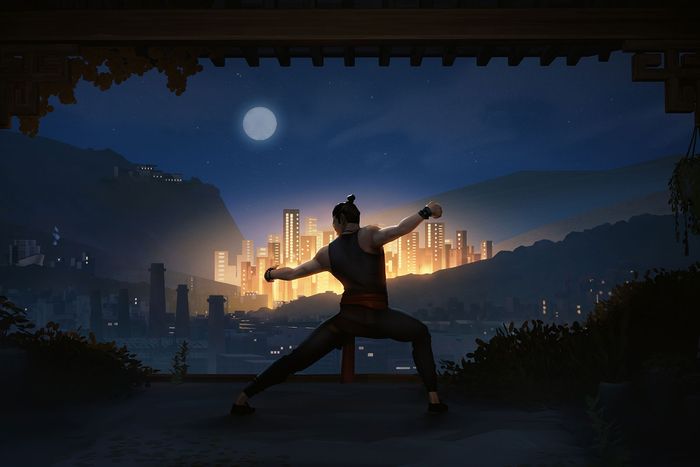
I’ve spent the last week getting my ass handed to me by Sifu, the new kung fu beat ’em up by Parisian studio Sloclap. My hands are slow, the game is blisteringly fast, and I’m tasked with dodging, parrying, and pummeling a near-constant onslaught of enemies. Sifu also contains occasional moments of respite — a few seconds here and there for me to regain my composure. In these windows of quiet, I find myself reeling through the Southeast Asian martial-arts-movie references the game has thrown at me. A tight apartment-block corridor with a cavalcade of bruising enemies? That’ll be Park-chan Wook’s Old Boy. Snow delicately falling on a deadly female assassin? Of course — Toshiya Fujita’s seminal 1973 picture Lady Snowblood.
Like Quentin Tarantino’s 2003 movie Kill Bill: Volume 1, Sifu attempts to distill an entire universe of martial-arts movies. Similar to that film and so many of those Tarantino gleefully cited, revenge is the engine that drives this story forward. In the moody opening level, you play a deadly martial artist who, alongside a handful of other comic-book-ish characters, is intent on killing a wizened master. You fight your way through a dojo, learning the ropes of the ultrafast, no-nonsense strain of Chinese kung fu known as Pak Mei until, eventually, you take out the elder. But hiding in the room is a 12-year-old child. Fast forward eight years, and you assume control of that child, now a young adult intent on avenging their father. There were five assassins, and so there are five levels, each culminating in a grueling boss fight. They need to die. That’s the entire plot.
Sifu is all action and zero emotion. Your motivations lack psychological depth, and the same is true for your enemies. These figures, who each embody one of the five Chinese elements, are simply waypoints in the larger game structure, and their elemental characteristics are reflected in the levels they bookend. The second is set in a neon nightclub that morphs into a burning training ground, the culminating boss wielding a flaming staff. There’s verve in the construction of these environments, the way they shift in front of your eyes (with an almost dreamlike logic) from real-life settings to altogether more impressionistic, stylized spaces. This is mostly fun and impressive, but occasionally you get the sense that each new scene is just an excuse for another movie reference. Why does the third stage, which takes place inside an art gallery, feature a monochromatic rain-soaked battle? Because it’s an iconic martial-arts image — a history Sifu desperately wants to be part of.
So where does Sloclap’s game differ from these films? By imparting a feeling of agency through participating in the combat rather than simply watching it (which almost makes up for the lack of character arcs and emotions elsewhere). If you’re anything like me — poor at remembering the suite of light and heavy attacks, bobs and weaves — this manifests initially as frustration. Eventually you get better, gaining confidence, and there comes a point where the combat starts to click. That is, until you come up against bosses such as the artist Kuroki in the third level’s nightmarish art gallery. She, especially, will bring you back to Earth with a skull-cracking thump.
Thankfully, as in most games (but very few films), death isn’t the end in Sifu. When you die, you resurrect, except you return a little older. You start the game at 20, and the first time you perish, you come back as 21. With each subsequent passing, your “death counter” rises, which means you age more quickly. If you’re not careful, you’ll be 70 by the time you finish the first level — one more death and it’s curtains for good. As you age (wrinkles and all) your enemies stay young, thus contributing neatly to the game’s surreal, at times metaphysical approach to aesthetics.
The aging mechanic means you need to make it through each level youthfully in order to have a decent shot at completing the next. But when you first finish a stage, you’ll likely have scraped through in your 60s — only enough life for a cursory look around the following stage. So you abandon the new area and replay the old until you’ve essentially mastered it — completion without losing a single year. The process is relentless, often demoralizing, and occasionally euphoric. Sloclap has described this repetitive structure of mastery in relation to the Chinese term kung fu, which translates as “a skill acquired through hard work and practice.” The game certainly makes you work hard for its payoffs.
In the end, Sifu doesn’t quite live up to its cinematic influences. Though every fight is meticulously orchestrated — with balletically choreographed and animated Pak Mei, a furious Howie Lee soundtrack, and bucketloads of film references — the cumulative effect is strangely wearying, and not just because of the difficulty. In this way, it reminds me of Tarantino’s Kill Bill: Volume 1 because of what it lacks. That movie’s martial-arts fantasy was enriched by Volume 2, in which the story was developed and the characters finally began to resonate. Sifu is undeniably impressive, but combat aside, it’s curiously shallow. With little to root for or indeed care about, you and the protagonist may ask yourselves the very same question: Is all this extremely stylish, time-consuming vengeance really worth it?

